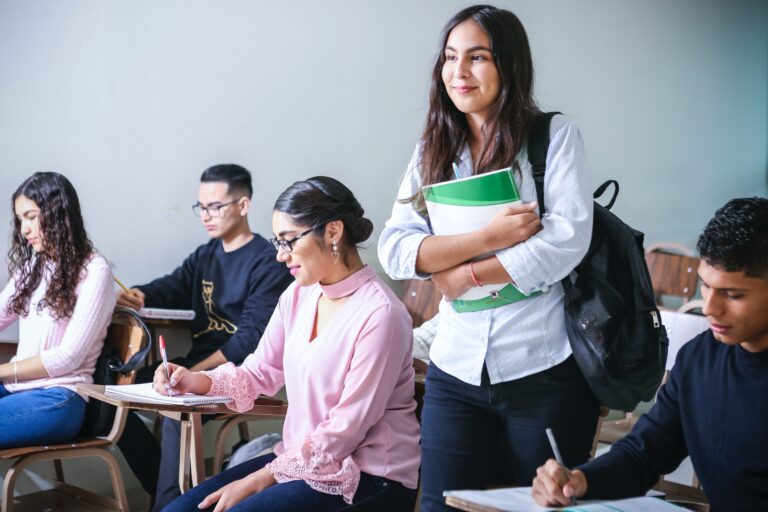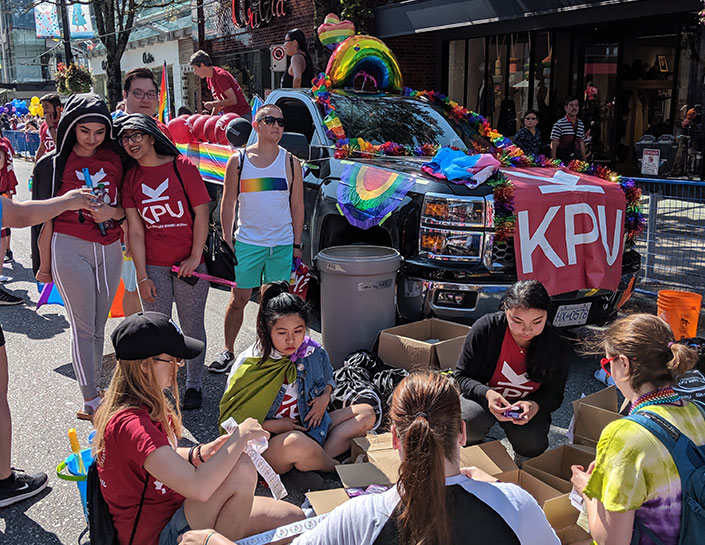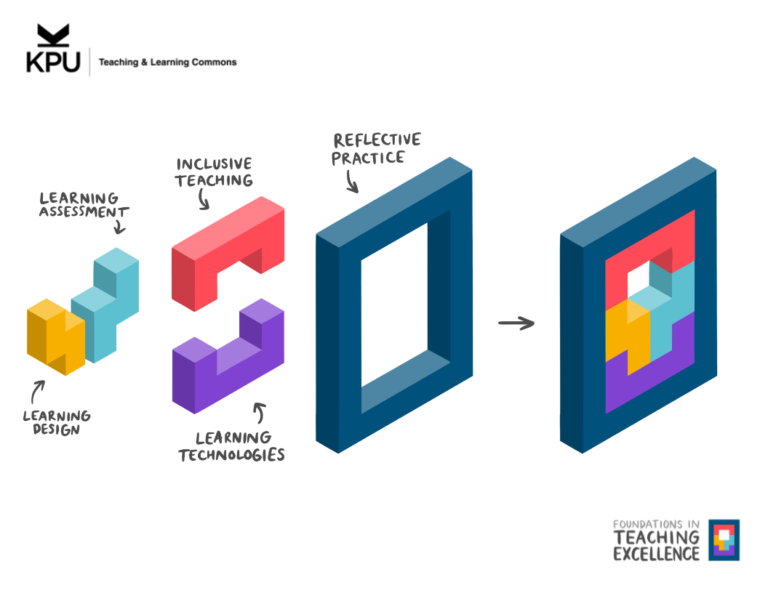Fourteen simple strategies to help KPU educators support Indigenous learners today! Lessons from the BCcampus Pulling together series

On Feb 6, 2023, KPU’s president Dr. Alan Davis released a video message providing guidance on delivering Territorial acknowledgments that shift away from “a general colonial term to the languages of these First Nations” (President’s update, 2023, 00:32). Positioning yourself through a Territorial acknowledgement should be an integral practice all of us at KPU has adopted.
Many KPU faculty are going deeper and connecting their current teaching context to their Territorial acknowledgments to generate dialogue with students about the critical history and current impacts of violent colonial forces on Indigenous, Métis, and Inuit peoples. This is good practice, and it is a vital part of the work needed to be done in post-secondary institutions (for guidance on developing more personalized and meaningful Territorial acknowledgements, see Len Pierre’s (2021) resource “Transformational Territorial Acknowledgements”). Still, this practice is only one small piece of the work critical to Indigenization, decolonization, and reconciliation in educational contexts. For example, what other immediate actions can educators take to support Indigenous learners in a structure which has historically not respected their cultural traditions and has systemically excluded their voices?
As a teaching and learning strategist, I have had conversations with many KPU educators who want to re-think their design and delivery approaches to support Indigenous learners better but often need help finding practical strategies they can implement to accomplish this goal.
Luckily, the fantastic humans at BCcampus are here to support action! In fact, they have developed a set of guides to support the incorporation of Indigenous epistemologies into professional practice specific to targeted professional audiences, including faculty, staff, administrators, leaders, researchers and curriculum developers. These guides were developed as part of a Ministry of Advanced Education, Skills and Training initiative in conjunction with a steering committee of post-secondary Indigenous education leaders, the First Nations Education Steering Committee, the Indigenous Adult and Higher Learning Association, and Métis Nation BC; to create OERs that could support the advancement of Indigenization efforts in British Columbia (BC) post-secondary institutions. Since publication, the Pulling Together guides have been further developed into online learning opportunities for each professional group. On their own, the Pulling Together guides are powerful resources that can provide excellent learning opportunities, but as Antoine et al. (2020) postulated:
The best approach to learning deeply about this topic is to use this guide in conjunction with hands-on learning activities, especially those that involve engagement with Indigenous communities and culture (Antoine et al., 2020, How to use and adapt this guide, para 4).
The whole team in the TL Commons recently participated in these online workshop offerings based on their roles. I was fortunate to participate in Pulling Together: A Guide for Curriculum Developers’ most recent offering.
Subsequently, I have synthesized fourteen simple strategies that KPU educators can incorporate into their practice to support Indigenous learners better; and support all the learners in their classes better (see Table 1).
These strategies are so simple to implement that regardless of what you teach or where you are in your learning journey, you can use them immediately!
For each strategy provided, there is guidance for where and how it could be incorporated, and additionally, each strategy shares a corresponding key learning from the Pulling Together series.
I suggest picking at least two strategies from this list (Table 1) and committing to incorporating them into your course(s) as soon as possible.
In the spirt of responsibility I reached out the facilitator, Tanya Ball, to ensure that these strategies were reflective of the session’s teachings.
Table 1
Fourteen simple strategies to help KPU educators support Indigenous learners today!
| Strategy | Where to do it | How to do it | Key learnings from Pulling Together |
| Tell stories | In person, in synchronous classes, in videos or audiocasts | Tell personal and traditional stories. | Tell personal stories and if you have permission to tell Indigenous stories; follow cultural protocol and ethical care (for example some Indigenous stories can only be told during certain seasons of the year) |
| Get personal | In person, in synchronous classes, in videos or audiocasts, in feedback | include pieces of yourself in lectures and encourage students to do the same. Let your guard down a little. | Have fun and laugh! The better time you are having, the better time the students are having! |
| Design holistic assignments | Activity, assignment, and assessment design | Provide opportunities for sharing assignment deliverables orally, and acknowledge the learner is a whole person by providing space for self-reflection rather than through a written assignment that is wholly academic | Allow for the inclusion of the mental, physical, spiritual, and emotional sides of oneself |
| Create lectures that encourage movement | In person, in synchronous classes, in videos or audiocasts | encourage students to use their body – allow movements and gestures that represent concepts or elements of the lesson | Moving the body has a positive impact on motivation, and engagement and allows for connection to mind body and spirit |
| Dismantle the power dynamic in your classroom | In person, in synchronous classes, in videos or audiocasts | Support the co-creation of group and individual course learning goals | Treat students how you wish to be treated |
| Push against the pan- Indigenous stereotype | In person, in synchronous classes, in videos or audiocasts | Include multiple Indigenous worldviews by Including content and activities that amplify the voices of Indigenous leaders, heroes, and artists | Consider how you can integrate Métis, Inuit, and Urban Indigenous peoples’ sources of knowledge into your courses, in addition to First Nations content Indigenous Literatures are their own thing. It is not a subgroup of CanLit – Indigenous Literatures frame experiences of Indigenous histories, colonization, and contemporary realities |
| Provide opportunities for self-reflection | Course and assignment design, asynchronous and synchronous activities | Make space for personalization, of learning and leave room for self-assessment that supports students reflecting on their own growth and development | This helps students to focus inward and helps to prevent judgement and anxiety. |
| Encourage students to incorporate the Land as a part of their process | Course and assignment design, in person, online synchronous classes | Host some classes outdoors and become knowledgeable in the historical, cultural and environmental significance of these outdoor spaces | Providing opportunities to connect to the Land will benefit all students |
| Be flexible with deadlines | Course and assignment design | Make some assignment deadlines flexible, let students set their own deadlines; or set quiz settings to be open for a period of 24 hours instead of one specified hour of the day | Understand that this class may not be always a top priority in student’s minds |
| Offer space during class time for students to visit with each other | In person classes, field trips and and in online synchronous classes | Encourage students to share with each other and allow students to get off topic to create a safe space and a community | Visiting is a crucial part of Indigenous cultures, supports connection and builds trust. You must consider visiting as a part of relationship building – Get out your teacups. |
| Take time during one-on-one meetings to “catch up” and check in | In person, online in virtual office hours (Zoom, Teams, BBB) | Take the first five minutes of the meeting to have meaningful conversations and allow for banter unrelated to the course or the students’ progress in the course | This is an opportunity for you to connect and to build trusting relationships |
| Encourage intergenerational learning with your assignments | Assignment design, online synchronous and asynchronous activities | Stay informed of cultural and community events and allow space for students to share about these if they choose to | It is important to create opportunities that support Indigenous students in making meaningful connections between what they are learning and the traditions and teachings of their families |
| Provide bonus assignments for community engagement | Course and assignment design | Encourage students to engage in projects which involve community connections | Connections to the community are vital, and some of the most meaningful learning happens through our relationships |
| Bring food or have a potluck | In person classes, field trips | Have an outdoor picnic to celebrate course milestones or to connect on a field trip through a shared meal | Sharing food in Indigenous culture (don’t confuse a potluck with a potlatch) is traditional, and celebratory and brings students together |
Let’s go beyond providing Territorial acknowledgements and incorporate some (or all) of these strategies within our classes to create more engaging and inclusive learning experiences for Indigenous learners at KPU; these guides and learning opportunities can help us take action!
_____________________________________________
Here are some KPU Indigenous resources and supports that you can access and that you can provide to your learners. The Teaching and Learning Commons would invite members of the KPU community to share any additional resources that may be absent from this list or resources that have been useful for their learning journey or teaching practice:
- Indigenous services for students
- Resources for KPU Indigenous and broader Indigenous community
- Indigenous student career resources
- Resources for Indigenous entrepreneurs
- KPU’s Gathering Place for Indigenous students
Find bursary and scholarship info here https://www.kpu.ca/careers/career-resources-indigenous-students
People Resources:
Rachel Chong Indigenous Librarian https://libguides.kpu.ca/prf.php?account_id=145317
References
Asma-na-hi Antoine, A., Mason, R., Mason, R., Palahicky, S., & Rodriguez de France, C. (2020). Pulling together: A guide for curriculum developers. Victoria, BC: BCcampus. https://opentextbc.ca/indigenizationcurriculumdevelopers/ CC BY-NC.
BCcampus. (2020). Meaningful Integration of Indigenous Epistemologies and Pedagogies – Pulling Together: A Guide for Curriculm Developers. https://opentextbc.ca/indigenizationcurriculumdevelopers/chapter/topic-indigenous-epistemologies-and-pedagogies/

Lisa Gedak
As one of KPU's Teaching & Learning Strategists, Lisa supports faculty through various methods, including workshops, webinars, and individual and group consultations. She is passionate about instructional design, the intersection of pedagogy and technology, and philosophical approaches supporting learner-centred education. Lisa has her Master's in Learning and Technology (MALAT).




